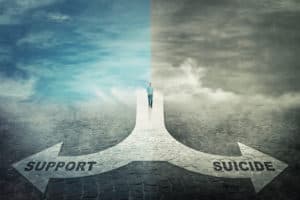Teen Suicide: Could Your Teen Be Next?
As a concerned and loving parent, you have done your suicide prevention research, read the articles, listened to the experts. You’re pretty sure that you know the warning signs of suicide among teenagers, and as far as you can tell your child appears to be okay. There are no worrisome messages on their phones to friends, no moodiness, no outbursts, no complaints or threats.
Mary Warren, Independent Educational Consultant and founder of Empower My Teen, which specializes in placing at-risk teens, commented that “Most parents only know the tip of the iceberg about their teen’s alcohol and drug consumption. What I hear almost daily is:
“My son is smoking weed but nothing more!”
While that may be true for some, it is not true for a lot of teens. They are only allowing their parents to know so much and a lot of the time parents have a strong GUT feeling that there might be more.
Please listen to that strong feeling! We need to help them before it is too late!”
Below is an article that was reported in one media outlet underscoring exactly this dilemma: what to do about supposedly “okay” teens who have shown few or no outward symptoms of depression or other indications of suicidal thoughts. How do we identify and save those kids?
“Good kids” Can Have Troubles Too: Lessons Learned Too Late
Seventeen-year-old Nathan Cowsert and his lacrosse teammate Jeremy Shipp, 16, were two young men who should have had their lives and bright futures ahead of them. The Brigham City, Utah teens were not only accomplished lacrosse players – Nate was captain of his Box Elder Bees’ lacrosse team – but active and involved teens who enjoyed working out as well as the outdoors.
As, the teens’ deaths occurred about six months apart. Nate took his life first, leaving behind stunned family, friends and teammates coping with their heartbreaking loss. Then, Jeremy Shipp, Nate’s teammate and a motivated and music-loving student who taught himself to play guitar, also took his life.
Was he influenced by his friend’s death?
What thoughts did both teens hold that could have driven them to commit such a final act of despair?
Unfortunately for some parents, the answers may never come after the fact, so learning warning signs and keeping in close contact is critical. Coaches, teachers, and others also need to learn to “read” signs that students may be sending out, and be willing and able to take action to intervene.
In the months since, their anguished parents and lacrosse coach have cast about searching for signs that may have been missed, to somehow make sense out of a senseless act. Jeremy’s father, EMT Jason Shipp, who had been a responder to Nathan’s death, had checked up on Jeremy, finding a worrisome text to a friend about thoughts of suicide. The older Shipp had asked his son whether he had thoughts of hurting himself, but was assured by Jeremy that things were alright, that it was “just a thought” that would never be acted upon.
Nate’s father David Cowsert suggested that their son may have been carrying a heavier course load than may have been desirable, leaving him overstretched and risking “burning the candle at both ends.” Nettie Goins, Nate’s mom added that in the minds of many teens, concerns that may seem small to parents and other adults may be magnified out of proportion, such as having a car accident, being in trouble with school or having a relationship break up. “All of these little things affect our children,” she added. “It could be (something) big or small.”
Experts agree that today’s youth are not only under more pressure from school academics and other activities than previous generations but teenagers’ brains process stress from pressure differently, feeling with more intensity while displaying more impulsiveness. Heavier class loads with the goals of accessing top colleges, along with the pressure to join in and succeed at activities such as sports, clubs, and the desire for popularity all add to the burdens.
The boys’ lacrosse coach, Juan Gaytan has also taken positive steps in his coaching strategies aimed toward prevention by having lunch with his three-dozen players, talking openly and other off-field quality time. His intent is to show them that “someone cares and that someone’s listening to them. That’s important.”
Jason Shipp expressed hope that others, such as parents and educators alike, will change their tactics, so that we can “figure out why this is happening and do what we can to stop it.” He added that while he never believed that it could happen to someone like Jeremy, “It can happen, and I don’t know the answer.”
Teen suicides are on the rise
Sadly, these two teens are part of a growing number of young people who chose to end their lives before they’d begun to fully live them. Although suicide accounts for 10th place among causes of death for all Americans, it ranked as a shocking second place for fatalities among young people aged 10 to 24, as well as being the second-leading cause of death among college age young people and youths 12 to 18.
According to the Jason Foundation’s statistics, suicide among teenagers and young adults account for more deaths in these age groups than cancer, birth defects, influenza, heart disease, pneumonia, chronic lung disease, AIDS and stroke combined.
Four out of five teen suicide attempts showed previous obvious warning signs.
Nationally, there are more than 3,000 attempts each day by youth in grades 9 through 12.
When the percentages are applied to those in grades 7 and 8, the numbers go even higher.
The above figures are from the Centers for Disease Control and Prevention’s most current (2017) data. The CDC’s Youth Risk Behavioral Surveillance System (YRBS) survey is performed every two years and measures the occurrences of risky behaviors, including suicidal threats and actions among youth.
Suicide statistic disparities among racial and ethnic groups are even more pronounced: the latest YRBS survey of 2017 showed that black students reported the highest attempt rates at suicide (9.8 percent) compared to 6.1 percent for white students. Overall out of the respondents approximately 2.4 percent reported making a suicide attempt requiring treatment by a medical professional. Of these, black students made up the highest numbers at 3.4 percent.
Females outnumbered males by 9.3 percent compared to 5.1 percent in attempted suicides. Males, however, tended to be more likely to carry out the suicide attempt to completion, perhaps because suicide methods differ between males and females, with younger males, as with adults, more likely to use firearms.
Suicides are on the rise among our youth, contributing to data that shows a lowered life expectancy across the spectrum. Studies have shown that racial disparities exist in suicidal behavior, particularly as many black Latino youth lack access to resources that could help intervene.
While suicide is 10th overall in cause of death among Americans of all ages, it is the second-leading cause of fatalities for youth aged 15 to 24. Worse, among black youth, self-reported incidents of suicidal thoughts and even attempts have actually increased by an astounding 73 percent over the past decade.
Entrenched racism, along with poverty and a feeling of helplessness, especially when attributed to police shootings and related socio-economic factors play significant roles in fostering a mentality of hopelessness among black communities at large. Media and other news outlets further contribute to the problems, particularly in how black communities are portrayed and black issues are covered – or not.
Suicide’s Warning Signs
Signs to watch out for possible suicide attempts may include any of the following:
- The person talks about feeling trapped or hopeless
- Talking about not having a purpose in life
- Talking about being in unbearable pain – either psychological or sometimes physical
- Talking about death and wanting to die
- Increasing use of drugs or alcohol
- Talk about not wanting to burden others
- Reckless, anxious or agitated behavior
- Looking for ways to kill oneself
- Having extreme mood swings
- Over or under-sleeping
- Withdrawal, especially from activities or people they once enjoyed
- Talking about getting revenge or showing rage
What Parent Should Do If Your Child Displays Warning Signs of Suicide:
Don’t leave the person alone, under any circumstances
Remove any weapons such as firearms or knives as well as drugs and alcohol that could be used to attempt suicide
Contact the U.S. National Suicide Prevention Hotline 1-800-273-8255 (TALK)
If possible, take the person to the nearest emergency room or get help from a qualified medical professional.
The Quiet Struggle: What to Do When Teens Won’t Talk
Many parents and their teenagers play a “game” of “don’t ask, don’t tell” as long as their children aren’t showing obvious signs of distress or mental illness, leaving their kids to suffer in silence as they grapple with mental health issues, according to Dr. Mark Goulston, a suicide prevention specialist. He has this advice for parents, many of whom may be overwhelmed by life events themselves:
They don’t want to distress their parents, many of whom may be dealing with an assortment of life issues: work, divorce, illness or other matters to which children are often perceptive. As a result, the teens don’t want to be a further burden on their families by adding more problems to their parents’ plates.
Teenagers who may already be feeling awful may be worried about magnifying those feelings further, adding to their mental distress. As a result, instead of healthy acknowledgment of feelings, they try to suppress them, causing more pain. Instead, acknowledge their struggles by telling them you’re sorry that you weren’t aware about the problems and that you want them to absolutely let you know whenever they’re feeling bad.
Dr. Soulston stresses that parents need to remember that just because their child isn’t showing obvious signs of sadness or other typical warning signs that they may still be dealing silently with darker thoughts that they don’t know how to handle. Letting your children know that they’re loved, listened to and taken seriously by parents can be one of the most loving and important discussions between parents and children.
What else can families do to save their children?
Clinical psychologist Heather Kelly of the American Psychological Association believes that there is need to research better ways to identify at-risk youth and develop more effective ways to prevent suicides. This is especially true for youth, young adults, veterans and members of the LGBTQ community. With a suicide jump of 73 percent, it is imperative that more attention needs to be paid to the issues and needs of black youth.
For black students, there needs to be better access to mental health treatment to stem the tide of suicidal attempts through increased investments in in-school mental health providers as well as promote a better understanding of the racial disparities in offering lifelines to black teens and older youths.
In too many black communities, children have little or no direct access to quality mental health facilities. A single mental health care provider may have to be shared among several schools, putting a strain on resources, time and care quality. For many black families, churches and prayer instead of qualified medical care have been used to treat mental health concerns. Further, there is often an unspoken stigma about needing help, which has blocked meaningful dialogue about teen suicide and other issues of troubled black youth.
According to Michael Lindsey, the director of the McSilver Institute for Poverty Policy and Research, more investment in resources that are culturally correct and based on proven evidence, with a trained, diverse healthcare workforce is needed to see improvements in reducing suicide attempts and other mental health outcomes among black teenagers. Parents and educators need to work together to ensure that schools and community centers offer a wider range of resources aimed at prevention.
A recent study showed potential in saving lives through encouraging teens recently discharged from hospitals following treatment for suicide attempts to partner with adults trained to talk to suicidal teens and encourage them to stay with treatment plans as well as reach out to be proactive.
Cheryl Kings, the lead author of a paper describing a small but significant clinical trial from a decade ago in JAMA Psychiatry explained that a group of teens who had been hospitalized for suicidal behaviors were asked following their discharge to select up to four trusted adults to receive training in suicide prevention and continuing support education – meaning that the adults were receiving the training and ongoing support, so they could then themselves support the teens.
Due to ongoing interest in the trial’s long term effects King and her colleagues found that among those who received the supportive treatment and those who didn’t, over the next 11 to 14 years, 13 control group participants died, mostly from drug overdoses. Of those who worked with supportive, trained adults, there were just two deaths.
Perhaps one clue to the success of the treatment is that the teens were able to choose the adults, and reinforce connections resulting in better choices later on.
While no one-size-fits-all plans or other answers exist for concerned parents attempting to protect vulnerable children, there are ways and places that offer preventive help. The National Suicide Prevention Hotline 1-800-273-8255 (TALK) is open 24 hours a day, seven days a week for those struggling with suicidal thoughts.
What Role Does Empower My Teen Play in Reducing Teen Suicide?
Empower My Teen is an organization which has worked with many families in crisis with troubled, at-risk youngsters. They have helped over a thousand families “get their son or daughter back” over the last 20 years by assessing and discovering which treatment program best works for a family’s specific needs and situation. An attempted teen suicide is almost always a “cry for help” and intervening in family dynamics often proves to be an effective way to identify an at-risk child and heal both child and the rest of the family.
The goal is to help parents assist in empowering their teens to make better choices to become a happy, well-adjusted and productive adult.
Mary helps parent find the right troubled teen program find placement in:
- Wilderness programs
- Residential treatment centers
- Drug and alcohol treatment programs
- Specialty therapeutic boarding schools
In addition, ongoing parental support is available in the form of parent coaching and emotional support. Parents learn new skill sets insights and tools to help heal the family in preparation for welcoming a healed child back home.
In the words of one parent: “We feel blessed having stumbled across Mary at Empower My Teen. She jumped in right away with genuine concern. Delivered us a perspective on what the core problem and opportunity was for our daughter. Mary helped organize the entire intervention, transport and placement effort. More than that, Mary didn’t cut and run. She is a special person and a true partner. Thanks again, Mary!”
Read other Empower My Teen testimonials and learn what parents say about Mary.
IF YOU THINK YOUR CHILD MAY BE STRUGGLING WITH THOUGHTS OF SUICIDE CONTACT:
The National Suicide Prevention Hotline 1-800-273-8255 (TALK) is open 24 hours a day, seven days a week.
If you suspect your child of suicidal ideation or your teen is struggling in another area of his or her life and you are worried about their future, schedule a complimentary consultation for Parent Coaching or to learn more about At-Risk Youth Placement.
Infographic: Suicide Prevention Awareness
To better understand the impact suicide is having among our teens, Screening for Mental Health released this infographic to raise awareness during the 2019 Suicide Prevention Month. Speak to your child and get help before it is too late. To help raise awareness please use the share buttons below to share this infographic to social media.







